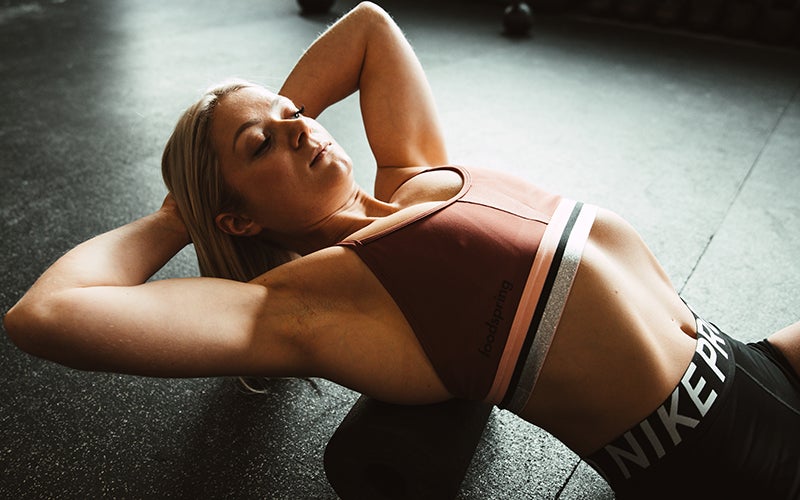Your Ideal Weight: Here’s how to calculate it and how to reach it
 ©Westend61
©Westend61
What could, or should, my weight be? This question isn’t that easy to answer, so we’re taking a closer look at the topic of ideal weight and why it’s important.
What is my ideal weight?
Lots of questions about the concept of an ideal weight tend to come up when you step on the scale or look in the mirror. Of course, our ideas about our own bodies are very personal and influenced by external factors. That’s why it’s really difficult to set one “perfect” number as a goal, especially when you don’t even know the reasons behind it.
In fact, since there’s no universally valid guideline for calculating ideal body weights, it’s important to listen to yourself instead of comparing yourself to others. At what weight do you feel good, fit, beautiful, and healthy? Listening to these instincts will take you closer to the path to your ideal weight and your definition of it.
Of course your instincts aren’t your only guideline, because science also provides some useful tools. You can use a number of different methods to find out what weight could be ideal for you. These guidelines are particularly informative when you compare them to your personal goal weight.
It’s useful to try out a couple of formulas to get to know your body better and get some perspective on your health. If your body weight falls outside a certain range, that might be a sign that you’re at risk for developing various physical ailments or illness.
Appropriate weight based on height: Calculating your ideal body weight by BMI
If you’ve tried to figure out your ideal weight before, you’ve probably come across BMI, which is supposed to shed some light on the subject. The Body Mass Index is probably the most well-known reference value and is even recommended by the NHS to help you assess your own body weight. It compares your weight to your height, and the resulting value shows you whether you are underweight, overweight, obese, or healthy – so your ideal weight.
Since BMI does not distinguish between muscle and fat mass, it can be inaccurate and put very fit people in the overweight category. But it still serves as a useful guide and is helpful for determining what weight range is healthy for you.
Want to learn more about the Body Mass Index? Find out more, calculate your BMI and get personalized product recommendations with our body check.

An ideal body weight equation: Creff’s formula
Creff’s formula is more specific and precise than the BMI, because age and personal physique are also included in your ideal weight calculation. It distinguishes between three body types, namely “petite,” “average,” and “broad with heavy bones.”
Here’s how you calculate your ideal weight à la Creff:
- Use the formula for the “average build” category as a basis:
[(height in centimeters – 100) + (age / 10)] x 0.9
- The final result is your ideal weight in kilograms.
- If you put yourself in the “broad” category, multiply the final result by 1.1.
- If you put yourself in the “petite” category, multiply the final result by 0.9.
Here’s an example based on a person who’s 28 years old and 172 centimeters in height, according to their physique:
“Average” body type:
- [(172 – 100) + (28 / 10)] x 0.9 = 67.32
- Ideal weight is around 67 kilograms.
“Broad” body type:
- [(172 – 100) + (28 / 10)] x 0.9 x 1.1 = 74.052
- Ideal weight is around 74 kilograms.
“Petite” body type:
- [(172 – 100) + (28 / 10)] x 0.9 x 0.9 = 60.588
- Ideal weight is around 60.5 kilograms.
What is the WtHR ideal body weight formula?
Prefer to be on the safe side? Then the Waist-to-Height Ratio (WtHR) can provide you with a third opinion in your search for your ideal weight. In contrast to BMI, it doesn’t give you a guideline for an ideal weight directly, focusing on more concrete information about your health status, which plays an important role in figuring out your ideal weight.
The aim here is to compare waist size and height and thus take a closer look at your fat distribution. Excessive abdominal fat can mean that you’re at risk for various conditions and, in combination with being overweight, it can also increase your risk of diabetes or cardiovascular disease. This is exactly where the Waist-to-Height-Ratio comes in, because it helps you draw conclusions about abdominal fat and your health.
This is how your WtHR is calculated:
- Calculate your values for the formula as accurately as possible by measuring in the morning before breakfast.
- Measure your waist circumference by putting a tape measure around your stomach at the height of your navel. Exhale normally
- Use the following formula to calculate your WtHR:
- Waist circumference in centimeters / height in centimeters
- If you’re under the age of 40, you have a normal weight if the result is under 0.5.
- If you are between age 40-50, the result should be between 0.5 and 0.6.
- If you are 50 or older, the result should be under 0.6.
- If your result is higher than this value, you’re overweight.
Reaching your ideal weight: 5 tips for achieving your goal
Are the methods above and your gut feeling telling you that you’re still far from your personal ideal weight? Don’t worry! The first step towards your dream weight is making the decision to do something about your health and fitness.
The path toward achieving your goals isn’t as difficult as you might imagine. Still not sure? Keep scrolling for some tips and inspiration to help you lose weight:
- Take the pressure off by forgetting about any diets that take away the fun of reaching your ideal weight. If you’re demotivated in advance, you’ll keep your mind and body from reprogramming themselves, and get in the way of your own progress. It’s a better strategy to disrupt your past habits and make a long-term transition to a healthy lifestyle.
- Easier said than done? Sounds like you haven’t seen our weight loss recipes! They give you a good overview of how much variety healthy eating can have. Trying out different dishes at the beginning makes changing your diet much more fun. Click here for our recipes.
- If you want to lose weight to reach your ideal weight, you’ll need to maintain a moderate calorie deficit. But ravenous hunger pangs can quickly put a damper on that. Before you give into your cravings, drink a glass of water and try healthy snacks. By the way, they’re also a valuable source of vitamins and minerals – making your mind and body feel fitter right away.
- If you want something sweet, find alternatives to snacks that have lots of sugar and calories. Protein Bars taste at least as good as most snack bars and fill you up for much longer, while, as the name suggests, they pack a healthy serving of protein and have fewer calories.
- Combine cardio and strength training. The former will help you burn lots of calories and lose weight, while working out with weights strengthens and shapes your body. By the way, doing strength training means you can eat more and still lose weight.
Motivated to finally get to your ideal weight? Don’t spend too much time thinking about it, get started right away!
Conclusion:
- There’s no one ideal weight, just guidelines.
- Defining your ideal weight is a completely individual process.
- Listen to your body and figure out the weight you feel most comfortable with.
- BMI, the Creff formula, and the WtHR can all help you determine your ideal weight.
- Your ideal weight and your overall health are related.
- Don’t let fluctuations make you feel insecure! Stress and, for women, your menstrual cycle can also have a temporary influence on your weight.
Sources for this article
We at foodspring use only high-quality sources, including peer-reviewed studies, to support the facts within our articles. Read our editorial policy to learn more about how we fact-check and keep our content accurate, reliable, and trustworthy.
































